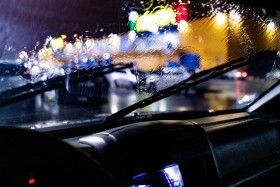What Does Obstructed View Mean in Michigan Traffic Law?

To drive safely, one of the most important things you can have is a clear view of the road. No matter how far you’ll be driving, it’s absolutely essential to see what’s going on around you on all sides. This is something that’s so important, most states have laws prohibiting obstructing vision through windshields and other windows on a car.
Obstructed view laws can cover many different things. Not only do they generally include things that can physically block or restrict a driver’s view of the road, such as window tints and signs, they also tend to cover requirements for parts of a car that are designed to help drivers see clearly, like windshield wipers, rear view mirrors, and window defrosters.
What are Michigan’s Obstructed View Laws?
Section 257.709 of the Michigan Vehicle Code covers obstructed views. This bans the following things:
-
Signs, posters, nontransparent material, reflective/non-reflective film, or window applications on the front windshield, side windows adjacent to the front passenger or driver, or sidewings immediately next to or ahead of the passenger or driver. However, a tinted film can be used along the top edge of the windshield, on side windows directly next to driver/passenger, or sidewings as long as the tint does not extend beyond four inches past the top of the window or lower than the shade band, whichever is closer to the top of the window.
-
Driving a vehicle if visibility through the rear window is obstructed, unless the vehicle has two rear view mirrors, one on each side, adjusted so that the driver has a clear view of the road behind them.
-
Rear windows or side windows behind the driver treated with a material that creates a total solar reflectance of 35% or more.
-
Objects that block the vision of the driver of the vehicle, except as authorized by law.
There are exceptions to these rules, including (but not limited to) necessary certificates/stickers (such as temporary license plates) that do not obstruct a driver’s view and special films prescribed by a physician or optometrist to address medical conditions.
This section also mandates that windshields of motor vehicles be equipped with a device for clearing rain, snow, and other moisture from the windshield which is operated by the driver. Windshield wipers must be well maintained and kept in good working order. If a car is licensed as a historic vehicle, windshield wipers are not required if they were not originally part of the vehicle.
Do You Need to Clear Snow from Cars in Michigan?
Snow is considered an object that obstructs a driver’s view of the road, which means drivers are required to clear it from their windshields and other windows. But how much snow needs to be removed from a car? Are drivers required to clear the snow from their car’s roof and headlights? Yes, although those are not specifically covered by the section of the Michigan Vehicle Code that applies to car windows.
Since snow can blow off of the roof of a car while in motion and potentially obstruct the view of the driver of the car or another driver, Section 257.677a(2)-(4) covers removing snow from cars. As for clearing headlights, multiple sections of the Michigan Vehicle Code (257.699, 257.686, and 257.697) outline requirements for the brightness for headlights and other lights on vehicles, and since snow can diminish the brightness of vehicle lights, it’s very important that snow be cleared from lights as well.
Contact a Michigan Car Accident Attorney
If you’ve been injured by a driver who violated Michigan’s traffic laws, it’s very important to get in touch with a Michigan car accident lawyer as soon as possible. At Goodwin & Scieszka, we have decades of experience helping the victims of Michigan car accidents and can help answer any questions you have about your case. Contact us today for help with your case.
Image: iStock / Михаил Руденко






